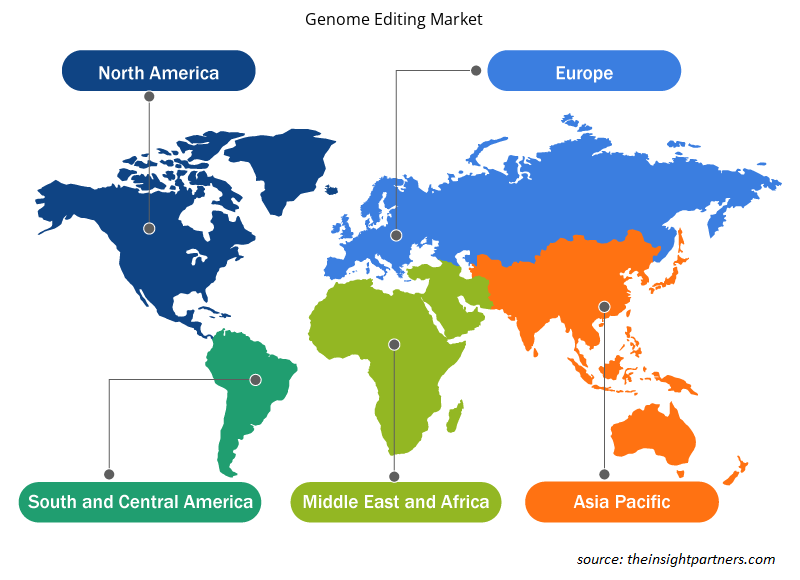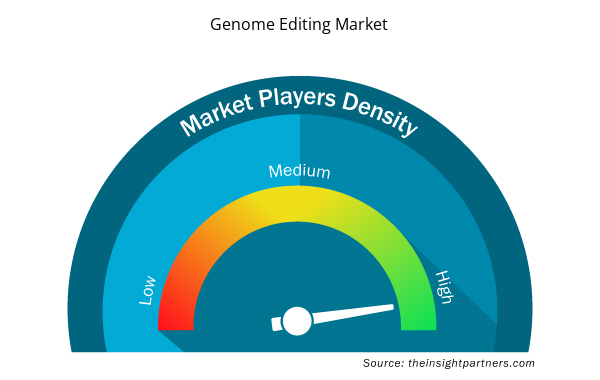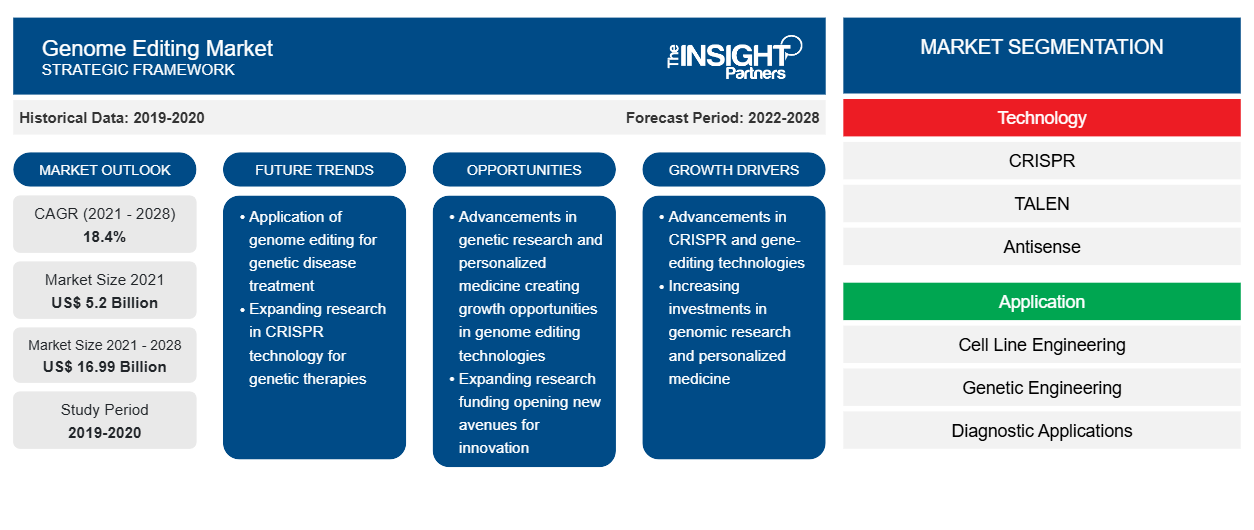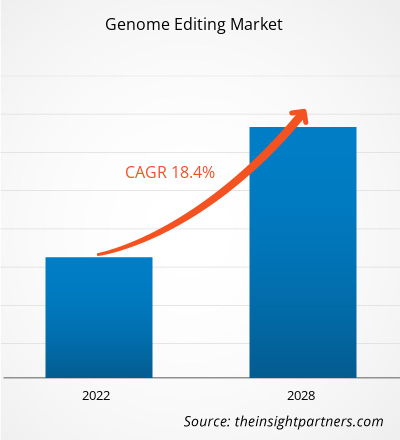[研究报告] 2021年基因组编辑市场规模价值为 51.994 亿美元,预计到 2028 年将达到 169.8669 亿美元;预计 2021 年至 2028 年的复合年增长率为 18.4%。
分析师观点
基因组编辑技术用于对细胞或生物体的 DNA 进行改变。该技术涉及切割 DNA 序列以添加或去除基因组中的 DNA。基因组的改变是为了获得细胞所需的特性。基因组编辑用于研究目的、疾病治疗和生物技术目的。全球基因组编辑市场的增长归因于癌症和其他遗传疾病患病率的上升,基因编辑工具的持续技术进步是推动市场增长的因素。此外,医疗 IT 的技术进步允许使用人工智能(AI) 来制造 CRISPR 系统,预计这将促进基因组编辑并在未来几年促进基因组编辑市场的增长。例如,2019 年 3 月,Oxford Biomedica plc 与微软研究院合作研发云和机器学习,以提高下一代基因治疗载体(如 LentiVector)的生产和质量。在此次合作下,Oxford Biomedica利用微软的Azure智能云平台开发计算机模型和创新算法,以推进下一代细胞和基因传递技术。
市场概况
基因组编辑或基因编辑是一种基因编辑,涉及插入、移除或替换生物体基因组中的 DNA,以使用工程核酸酶或分子剪刀治疗特定疾病。核酸酶在基因组中产生位点特异性双链断裂,然后通过非同源末端连接或同源重组进行修复,从而导致靶向突变。推动基因组编辑市场增长的一些因素包括癌症和其他遗传疾病的增加、对个性化医疗的日益偏好、私人和公共资金的增加以及测序和基因组编辑技术的快速发展。促进基因组编辑市场增长的另一个因素是合作。例如,礼来公司于 2020 年 11 月与 Precision BioSciences 合作,利用 ARCUS 平台开发遗传疾病的体内治疗,这一合作可以为北卡罗来纳州达勒姆的这家开发基因组编辑和 CAR T 免疫疗法的公司带来 27 亿美元的收入。因此,合作将在预测期内增加基因组编辑市场的增长。
定制此报告以满足您的需求
您可以免费定制任何报告,包括本报告的部分内容、国家级分析、Excel 数据包,以及为初创企业和大学提供优惠和折扣
- 获取此报告的关键市场趋势。这个免费样品将包括数据分析,从市场趋势到估计和预测。
市场驱动因素
癌症和其他遗传疾病患病率上升
根据世界卫生组织 (WHO) 的数据,癌症是全球最大的死亡原因,2020 年约有 1000 万人死于癌症。总体而言,全球癌症发病率和死亡率负担正在迅速增加,这既反映了人口老龄化和增长,也反映了主要癌症风险因素的流行程度和分布的变化,其中许多与社会经济发展有关。《今日癌症》基于 GLOBOCAN 对 185 个国家或地区 36 种癌症按性别和年龄组划分的发病率、死亡率和患病率的估计,对 2020 年全球癌症负担进行了全面评估。根据最近的估计,癌症的发病率一直在以惊人的速度增长,使肝细胞癌 (HCC) 成为男性第五大常见癌症和女性第七大常见癌症。HCC 可能占所有人类癌症的约 5.6%,从而增加 2020 年的负担。众所周知,HCC 是全球癌症相关死亡的第二大原因。近 85% 的 HCC 发生在发展中国家。其他类型的肝癌包括胆管细胞癌 (CCC)(一种肝胆管恶性疾病)和肝母细胞瘤。肝母细胞瘤是儿童最常见的肝脏恶性肿瘤。根据疾病控制和预防中心 (CDC) 的数据,在美国,每年约有 21,000 名男性和约 8,000 名女性患上肝癌,约有 16,000 名男性和 8,000 名女性死于该疾病。因此,全球肝病(包括慢性和急性疾病)患病率的上升以及微生物感染,增加了对肝脏模型的需求。
大约每 150 个活产婴儿中就有 1 个会检测到染色体异常。然而,即使如此高的发生率也只代表了染色体突变的一小部分,因为绝大多数都是致命的,会导致产前死亡或死产。事实上,据估计,50% 的妊娠前期流产和 20% 的妊娠中期流产都与染色体异常的胎儿有关。尽管唐氏综合症是最著名和最受认可的常染色体三体性综合症,但大约每 800 个活产婴儿中才有 1 个被诊断出患有这种疾病。许多癌症生物学研究现在使用 CRISPR 作为标准方法。CRISPR / Cas9 系统已被证明可有效治疗转移性肿瘤,这是发现癌症治疗方法的一大步。CRISPR-LNPs 系统包含一种信使 RNA,它编码 Cas9 CRISPR 酶,该酶可作为分子剪刀切割细胞的 DNA。基于 CRISPR 的研究为治疗脆性 X 综合征和唐氏综合征等遗传性或发育性神经系统疾病 (HND) 打开了新的大门。
因此,预计基因组编辑的增加因素将在预测期内推动基因组编辑市场的增长。
节段分析
技术洞察
根据技术,基因组编辑市场细分为 CRISPR、TALEN、反义和其他。由于其当前的使用情况、高消费量和产品创新,CRISPR 部分很可能在 2021 年占据最大的市场份额,预计在预测期内将在市场上实现最高的复合年增长率。成簇的规律间隔短回文重复序列 (CRISPR) 与 Cas 基因有关,这些基因对于选定的细菌和古细菌中的适应性免疫至关重要。CRISPR 使生物体能够对入侵遗传物质的变化和消除作出反应。有几种类型的 CRISPR 机制已被用于基因组编辑协议。第一种是野生型 Cas9,第二种是突变型 Cas9,第三种是核酸酶缺陷型 Cas9。
CRISPR-Cas9 比其他 DNA 编辑技术更快、更便宜、更准确,应用范围广泛。它是最简单、最通用、最精确的基因操作方法。提供 CRISPR 的公司包括 Sangamo Therapeutics、Editas Medicine、ThermoFisher Scientific、Horizon Discovery Groups 等。由于 CRISPR 简单、快速、准确的特性,预计该领域的市场将在未来几年以最快的速度增长。
应用程序洞察
根据应用,全球基因组编辑市场细分为细胞系工程、基因工程、诊断应用、药物发现等。2021 年,细胞系工程领域可能占据最大的市场份额。此外,由于全球各种医疗状况的检测和诊断增加,预计该领域的需求也将在 2021 年至 2028 年期间以最快的复合年增长率增长。细胞系工程主要在实验室中进行,目的是了解疾病和治疗背后的基本生物学。细胞系工程提供了许多好处,例如优化细胞系以进行重组蛋白表达和表征转基因生物的蛋白质谱。细胞系工程能够生产各种工业和商业产品,由于产品是按照所需要求生产的,因此可以获得更多的收入。
Horizon Discovery、ThermoFisher Scientific、Lonza、Merck KGaA、Biognosys 等市场参与者提供细胞系工程产品和服务。细胞系工程具有多种优势,例如经济高效、易于使用、提供无限的材料供应以及避免使用动物和人体组织所带来的道德问题。此外,细胞系工程还使研究人员受益于开发疫苗、测试药物代谢和细胞毒性、抗体生产、基因功能研究、人工组织的生成(以及生物化合物的合成)。因此,细胞系工程的优势在未来几年可能会大幅增长,预计将推动基因组编辑市场的增长。
最终用户洞察
根据最终用户,全球基因组编辑市场分为制药和生物技术公司、学术和研究机构以及临床研究组织 (CRO)。2021 年,制药和生物技术公司部门可能会占据最大的市场份额。此外,由于全球各种医疗状况的检测和诊断增加,预计该部门的需求在 2021 年至 2028 年期间也将以最快的复合年增长率增长。
区域分析
全球基因组编辑市场按地区细分为北美、欧洲、亚太地区、中东和非洲以及南美和中美洲。北美地区是全球基因组编辑市场的最大股东。美国和加拿大等国家普遍存在基因组编辑市场增长的现象,其驱动因素包括基因疗法的开发不断增加、公司和政府机构之间的合作不断增加、政府机构为推动 CRISPR 产品开发技术而增加的资金以及对基因组编辑的需求不断增加。由于越来越多地采用基因组编辑来治疗遗传疾病和癌症,预计墨西哥将为基因组编辑市场提供增长机会。此外,基因组编辑临床试验的不断增加预计将推动基因组编辑市场的发展。
在北美,美国是最大的基因组编辑市场。畜牧业为消费者提供各种产品和服务,包括肉类、牛奶、鸡蛋等。牲畜的遗传变异有助于生产出优质的原材料,通过自然选择进行进化,以应对不断变化的条件和人类管理的遗传改良计划。
此外,遗传性疾病的日益流行和用于治疗慢性病的先进 基因疗法的采用预计将在预测期内推动该国市场的发展。例如,根据美国国立卫生研究院国家医学图书馆 2021 年 7 月发布的数据,囊性纤维化是美国白人中常见的遗传病之一。该病的发病率为每 2,500 至 3,500 名白人新生儿中就有 1 名。然而,囊性纤维化在该国其他族群中相对较低。这些群体中的疾病发病率约为每 17,000 名非裔美国人中 1 名,每 31,000 名亚裔美国人中 1 名。此外,基因疗法在癌症治疗中的采用率不断提高、市场参与者正在推出相关产品、监管机构的支持等因素预计将支持美国的基因组编辑相关市场。例如,2021年5月,美国食品药物管理局(FDA)批准Lumakras(Sotorasib)用于针对肿瘤表达KRAS基因G12C突变的非小细胞肺癌患者的靶向治疗。
Thermo Fisher Scientific Inc.;Merck KGaA;Lonza;Horizon Discovery Group plc.;Integrated DNA Technologies;GenScript;New England Biolabs;Eurofins Scientific;CRISPR Therapeutics 和 Editas Medicine 是全球基因组编辑市场增长的主要参与者。为了全面了解市场及其生态系统,还分析了其他几家重要的市场参与者。该报告提供了详细的市场洞察,可帮助主要参与者制定基因组编辑市场增长战略。以下提到了一些发展:
基因组编辑市场区域洞察
Insight Partners 的分析师已详细解释了预测期内影响基因组编辑市场的区域趋势和因素。本节还讨论了北美、欧洲、亚太地区、中东和非洲以及南美和中美洲的基因组编辑市场细分和地理位置。

- 获取基因组编辑市场的区域特定数据
基因组编辑市场报告范围
| 报告属性 | 细节 |
|---|---|
| 2021 年市场规模 | 52亿美元 |
| 2028 年市场规模 | 169.9 亿美元 |
| 全球复合年增长率(2021 - 2028) | 18.4% |
| 史料 | 2019-2020 |
| 预测期 | 2022-2028 |
| 涵盖的领域 | 按技术分类
|
| 覆盖地区和国家 | 北美
|
| 市场领导者和主要公司简介 |
|
基因组编辑市场参与者密度:了解其对业务动态的影响
基因组编辑市场正在快速增长,这得益于最终用户需求的不断增长,这些需求源于消费者偏好的不断变化、技术进步以及对产品优势的认识不断提高等因素。随着需求的增加,企业正在扩大其产品范围,进行创新以满足消费者需求,并利用新兴趋势,从而进一步推动市场增长。
市场参与者密度是指在特定市场或行业内运营的企业或公司的分布情况。它表明在给定市场空间中,相对于其规模或总市场价值,有多少竞争对手(市场参与者)存在。
在基因组编辑市场运营的主要公司有:
- 赛默飞世尔科技公司
- 默克集团
- 龙沙
- 地平线探索集团有限公司
- 集成 DNA 技术
免责声明:上面列出的公司没有按照任何特定顺序排列。

- 获取基因组编辑市场顶级关键参与者概述
- 2021 年 11 月,领先的综合基因组学解决方案提供商 Integrated DNA Technologies (IDT) 推出了其 rhAmpSeq CRISPR 分析系统,该系统提供了端到端解决方案,用于表征和量化 CRISPR 研究项目中各种在靶和脱靶基因组编辑事件。
- 2021年12月,领先的基因组编辑公司Editas Medicine, Inc.宣布,美国食品药品监督管理局(FDA)已批准EDIT-301用于治疗输血依赖性β地中海贫血(TDT)的IND,使该公司能够启动EDIT-301对TDT患者的1/2期临床研究。
- 2020 年 8 月,Horizon Discovery Group plc(一家在细胞系工程中应用基因编辑和基因调节的全球领导者)今天宣布,将单细胞 RNA 序列关联的 CRISPR 筛选添加到其 CRISPR 筛选服务组合中。该平台提供高质量的筛选数据和生物学见解,以解决靶标识别和验证中的关键差距。
- 2021 年 12 月,Eurofins Scientific 同意从 Transgenic 收购日本检测服务提供商 Genetic Lab (G Lab),收购金额不详。G Lab 致力于提供基于分子生物学的诊断、生物标志物开发和药物发现测试。
- 2021年5月,领先的生命科学试剂供应商New England Biolabs, Inc.宣布已达成协议,收购总部位于英国的冻干研发服务公司Fluorogenics Limited(FGL)。根据协议条款,FGL将成为NEB的全资子公司。
- 历史分析(2 年)、基准年、预测(7 年)及复合年增长率
- PEST 和 SWOT 分析
- 市场规模价值/数量 - 全球、区域、国家
- 行业和竞争格局
- Excel 数据集



Report Coverage
Revenue forecast, Company Analysis, Industry landscape, Growth factors, and Trends

Segment Covered
This text is related
to segments covered.

Regional Scope
North America, Europe, Asia Pacific, Middle East & Africa, South & Central America

Country Scope
This text is related
to country scope.
常见问题
The global genome editing market based on technology, is segmented into CRISPR, TALEN, Antisense, and others. The CRISPR segment held the largest share of the market in 2021 and register the highest CAGR during the forecast period.
Genome editing technologies enable scientists to change DNA, leading to changes in physical traits, like eye color and disease risk. Scientists use different technologies to do this. These technologies act like scissors, cutting the DNA at a specific spot. Then scientists can remove, add, or replace the DNA where it was cut. CRISPR is simpler, faster, cheaper, and more accurate than older genome editing methods. Many scientists who perform genome editing now use CRISPR.
The genome editing market majorly consists of the players such as Thermo Fisher Scientific Inc.; Merck KGaA; Lonza; Horizon Discovery Group plc.; Integrated DNA Technologies; GenScript; New England Biolabs; Eurofins Scientific; CRISPR Therapeutics; Editas Medicine amongst others.
The factors that are driving and restraining factors that will affect the genome editing market in the coming years. Factors such as the rising prevalence of cancer, the growing rate of genetic disorders. However, the high cost of genomics hampers the genome editing market.
Trends and growth analysis reports related to Life Sciences : READ MORE..
The List of Companies - Genome Editing Market
- THERMO FISHER SCIENTIFIC INC.
- MERCK KGaA
- Lonza
- Horizon Discovery Group plc.
- Integrated DNA Technologies
- GenScript
- New England Biolabs
- Eurofins Scientific
- CRISPR Therapeutics
- Editas Medicine
The Insight Partners performs research in 4 major stages: Data Collection & Secondary Research, Primary Research, Data Analysis and Data Triangulation & Final Review.
- Data Collection and Secondary Research:
As a market research and consulting firm operating from a decade, we have published and advised several client across the globe. First step for any study will start with an assessment of currently available data and insights from existing reports. Further, historical and current market information is collected from Investor Presentations, Annual Reports, SEC Filings, etc., and other information related to company’s performance and market positioning are gathered from Paid Databases (Factiva, Hoovers, and Reuters) and various other publications available in public domain.
Several associations trade associates, technical forums, institutes, societies and organization are accessed to gain technical as well as market related insights through their publications such as research papers, blogs and press releases related to the studies are referred to get cues about the market. Further, white papers, journals, magazines, and other news articles published in last 3 years are scrutinized and analyzed to understand the current market trends.
- Primary Research:
The primarily interview analysis comprise of data obtained from industry participants interview and answers to survey questions gathered by in-house primary team.
For primary research, interviews are conducted with industry experts/CEOs/Marketing Managers/VPs/Subject Matter Experts from both demand and supply side to get a 360-degree view of the market. The primary team conducts several interviews based on the complexity of the markets to understand the various market trends and dynamics which makes research more credible and precise.
A typical research interview fulfils the following functions:
- Provides first-hand information on the market size, market trends, growth trends, competitive landscape, and outlook
- Validates and strengthens in-house secondary research findings
- Develops the analysis team’s expertise and market understanding
Primary research involves email interactions and telephone interviews for each market, category, segment, and sub-segment across geographies. The participants who typically take part in such a process include, but are not limited to:
- Industry participants: VPs, business development managers, market intelligence managers and national sales managers
- Outside experts: Valuation experts, research analysts and key opinion leaders specializing in the electronics and semiconductor industry.
Below is the breakup of our primary respondents by company, designation, and region:

Once we receive the confirmation from primary research sources or primary respondents, we finalize the base year market estimation and forecast the data as per the macroeconomic and microeconomic factors assessed during data collection.
- Data Analysis:
Once data is validated through both secondary as well as primary respondents, we finalize the market estimations by hypothesis formulation and factor analysis at regional and country level.
- Macro-Economic Factor Analysis:
We analyse macroeconomic indicators such the gross domestic product (GDP), increase in the demand for goods and services across industries, technological advancement, regional economic growth, governmental policies, the influence of COVID-19, PEST analysis, and other aspects. This analysis aids in setting benchmarks for various nations/regions and approximating market splits. Additionally, the general trend of the aforementioned components aid in determining the market's development possibilities.
- Country Level Data:
Various factors that are especially aligned to the country are taken into account to determine the market size for a certain area and country, including the presence of vendors, such as headquarters and offices, the country's GDP, demand patterns, and industry growth. To comprehend the market dynamics for the nation, a number of growth variables, inhibitors, application areas, and current market trends are researched. The aforementioned elements aid in determining the country's overall market's growth potential.
- Company Profile:
The “Table of Contents” is formulated by listing and analyzing more than 25 - 30 companies operating in the market ecosystem across geographies. However, we profile only 10 companies as a standard practice in our syndicate reports. These 10 companies comprise leading, emerging, and regional players. Nonetheless, our analysis is not restricted to the 10 listed companies, we also analyze other companies present in the market to develop a holistic view and understand the prevailing trends. The “Company Profiles” section in the report covers key facts, business description, products & services, financial information, SWOT analysis, and key developments. The financial information presented is extracted from the annual reports and official documents of the publicly listed companies. Upon collecting the information for the sections of respective companies, we verify them via various primary sources and then compile the data in respective company profiles. The company level information helps us in deriving the base number as well as in forecasting the market size.
- Developing Base Number:
Aggregation of sales statistics (2020-2022) and macro-economic factor, and other secondary and primary research insights are utilized to arrive at base number and related market shares for 2022. The data gaps are identified in this step and relevant market data is analyzed, collected from paid primary interviews or databases. On finalizing the base year market size, forecasts are developed on the basis of macro-economic, industry and market growth factors and company level analysis.
- Data Triangulation and Final Review:
The market findings and base year market size calculations are validated from supply as well as demand side. Demand side validations are based on macro-economic factor analysis and benchmarks for respective regions and countries. In case of supply side validations, revenues of major companies are estimated (in case not available) based on industry benchmark, approximate number of employees, product portfolio, and primary interviews revenues are gathered. Further revenue from target product/service segment is assessed to avoid overshooting of market statistics. In case of heavy deviations between supply and demand side values, all thes steps are repeated to achieve synchronization.
We follow an iterative model, wherein we share our research findings with Subject Matter Experts (SME’s) and Key Opinion Leaders (KOLs) until consensus view of the market is not formulated – this model negates any drastic deviation in the opinions of experts. Only validated and universally acceptable research findings are quoted in our reports.
We have important check points that we use to validate our research findings – which we call – data triangulation, where we validate the information, we generate from secondary sources with primary interviews and then we re-validate with our internal data bases and Subject matter experts. This comprehensive model enables us to deliver high quality, reliable data in shortest possible time.


 获取此报告的免费样本
获取此报告的免费样本